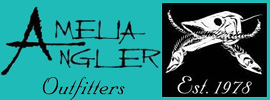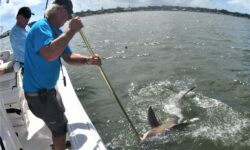"Amelia Island Sheepshead"
By Terry Lacoss
The "2020 El Cheapo Sheepshead Tournament" was held this past Saturday, March 14th under windy conditions, but there were some big catches made.Randal Archer weighed in the largest sheepshead at 10.94-pounds winning a brand new 2020 Carolina Skiff outfitted with a 115 Suzki outboard and Magic Tilt trailer. First place winnings totaled some $75,000.00.Hunter Pepper took top Junior Angler honors with a 7.52-pound sheepshead. Rachel Schmidt was the top "Lady Angler" with a 8.20-pound sheepshead and Edison Pedro topped all Kayak competitors with a 7.46-pound sheepshead. The "Annual El Cheapo Sheepshead Tournament" is rapidly becoming one of the Southeast's largest fishing tournament with over 450 competitors fishing in the event.
The Jacksonville Offshore Fishing Club presents the tournament each year and is backed by several local sponsors. This year the event was limited to the backwaters as there were high winds and a "Small Craft Warning".
"It was too rough to even get out to the jetties," Kenny Crawford said. "They limited the tournament to the backwaters which totally changed our game plan while fishing close to barnacle clad dock pilings located at the "West Rock" papermill. Our largest sheepshead weighed just over 5-pounds."
Amelia Island sheepshead are plentiful offshore, particularly where there are plenty of crustaceans growing on wrecks, broken concrete and similar bottom structures. The annual winter/spring spawn is typically triggered by the moon and also water temperature too. Like many species of both fresh and saltwater game fish, sheepshead typically will spawn just before and right on a full moon. With this in mind during the months of March through April N.E. Florida sheepshead will be laying their eggs when the moon is full and more importantly when there are stable weather conditions.
Sheepshead are by far one of the best eating fish that are found in our Northeast Florida waters and more importantly easy to catch when you have figured out their uncommon feeding habits.
Fishing tackle is key when catching toothy sheepshead, which at times, can be very tricky in their feeding habits. Terminal fishing gear includes twenty pound spinning or level wind tackle, both should be spooled with twenty pound hi-viz braided fishing line that will offer the sensitivity that you will need to detect that sneaky sheepshead bite. A one to four-ounce egg sinker is threaded on to the braided line, using just enough weight to keep the bait down next to the piling, or structure. A twenty pound barrel swivel is then tied to the tag end of the braided fishing line. Next, a twelve-inch section of twenty-pound fluorocarbon shock leader is tied to the remaining side of the barrel swivel. Finally a size four Kahle hook is tied to the business end of the shock leader.
Sheepshead strikes are often very difficult to detect while a foraging sheepshead will often swim up with your barbed bait eat it and spit it out without the slightest hint of a strike. Keeping a tight fishing line, while raising and lowering the rod tip, is a good tip for detecting a sneaky sheepshead strike. Best baits for sheepshead include fiddler crabs, small pieces of fresh shrimp or squid.
Some of the better locations for catching winter sheepshead include near shore wrecks, artificial reefs, jetty rocks, bridge and dock pilings. As stated earlier in the article some of the larger adult sheepshead are located offshore during the winter fishing season where they find plenty of crustaceans and perfect conditions for spawning. A favorite offshore sheepshead location includes “KBY" artificial reef where broken concrete is scattered over a wide area of the bottom.
KBY—stands for Kings Bay, which is an artificial reef project located some six miles northeast of the St. Mary’s Inlet, latitude 30-46.65’N, longitude 81-17.32’W. The KBY reef was constructed of materials from the old Kings Bay wharf, and consists of broken concrete and pilings. The reef system encompasses some one and a half square miles of bottom.
The current Florida regulations on sheepshead allow fishermen to keep fifteen per day measuring at least 12-inches. For more Florida fishing regulations visit www.myfwc.com










